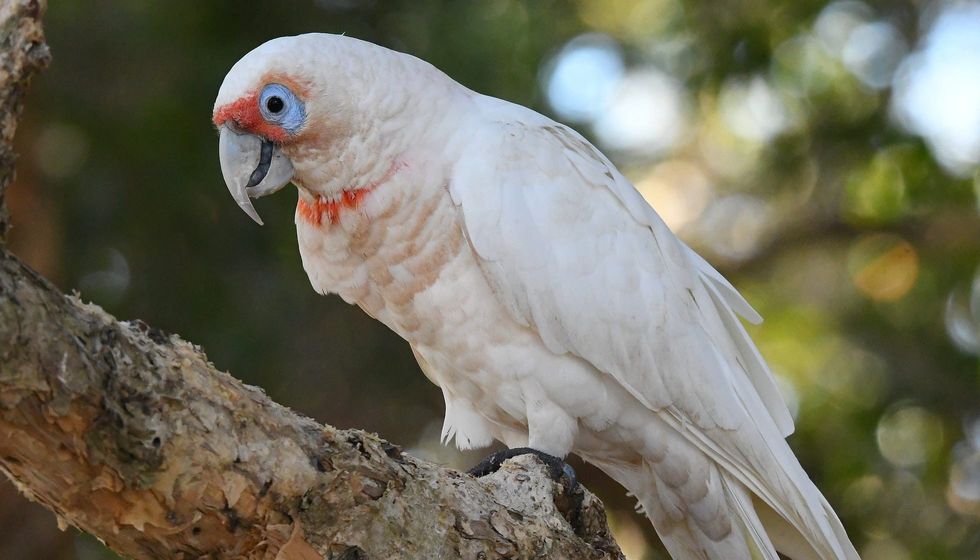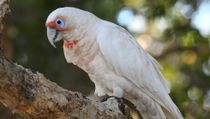Cockatoos are a subgroup of parrots that includes these little corellas, Cacatua sanguinea. These corellas are mostly white and are commonly known as bare-eyed cockatoo, blood-stained cockatoo, little cockatoo, and blue-eyed cockatoo.
Three of the six corella species are mostly found in Australia, with one endemic species in each of the Philippines, Indonesia, and the Solomon Islands. The little corellas are most popularly found in Australia and the western corella is confined from the extreme south to the west of western Australia.
The bare-eyed cockatoo is not the most colorful parrot on the planet, but it makes up for it with a vibrant personality. So if you ever do visit Australia, do make sure to take a lot of photos of these birds.
The bare-eyed cockatoos are sweet, playful, and intelligent birds. They are very good at mimicking human voices but are less talkative as compared to other cockatoos. These birds can even learn to do tricks and are very social and affectionate toward their owner.
Want to know more about the little corellas, see its photos, and read more interesting facts? Then do read on and after, check out the Cape starling and Atlantic canary.
Little Corella Interesting Facts
What type of animal is a little corella?
The little corella (Cacatua sanguinea) is a type of bird belonging to the family Cacatuidae.
What class of animal does a little corella belong to?
The little corella is a bird belonging to the class of Aves. C. s. westralensis, C. s. sanguinea, C. s. normantoni, C. s. transfreta and C. s. gymnopis are the five subspecies of little corella birds.
How many little corellas are there in the world?
Although no accurate statistics on the population of these little corellas are available, the population trend is thought to be increasing.
Where does a little corella live?
The little corella mostly lives in open woodlands near seeding grasses. They are also found in urban areas where they feed on lawns and playing fields. Increased cultivation has resulted in a rise in the number of these birds, which might become a problem in certain regions.
What is a little corella's habitat?
Little corellas are found all over Australia. The habitat varies from central Australia's arid deserts to the eastern coastal plains, but they don't live in forests.
The five different subspecies are also found in different places as C. s. gymnopis are seen in Central, Eastern, and, South-eastern Australia, and C. s. transfreta is found in New Guinea, and C. s. normantoni are frequently in the Western Cape York Peninsula.
Who do little corellas live with?
Little corellas are mostly found in packs. They form large flocks especially along watercourses while searching for food or water. Sometimes different birds like galahs and red-tailed black cockatoo join the flock too.
How long does a little corella live?
The little corella lifespan has been known to be up to 50 and even 80 years in captivity.
How do they reproduce?
The little corella (Cacatua sanguinea) can breed at the start of a lengthy spell of rain and this usually occurs from May to October. The nest site is often built up of a proper tree hollow stuffed with shavings of sapwood and a termite hill that is used for numerous years in a row.
Two to four whitish eggs are laid by the female.
Both adults share the incubation period, which lasts around 25 days, and then both the parents take care of the young chick. These little corellas also lay nests in large colonies because of which many nests can be seen in a single tree.
What is their conservation status?
The conservation status of this species of bare-eyed cockatoo is classified as Least Concern under the IUCN red list. This species has a very vast range, and the population trend looks to be rising, thus it does not meet the criterion for being vulnerable in terms of population trend.
Little Corella Fun Facts
What do little corellas look like?
A pale rose-pink patch that is present in between the eye and the bill is a characteristic feature of these birds. The underwing and under tail have a bright sulfur-yellow wash in flight.
In terms of weight, wing length, culmen size, tarsus length, tail length, and eye-ring diameter, females are somewhat smaller than males but both males and females have similar plumage and young birds look like adults but are smaller in size.
How cute are they?
The bare-eyed cockatoo has a fleshy blue eye-ring and a pale rose pink patch, making them one of the cutest birds. During flight, a bright sulfur-yellow wash is seen on the underwing and under the bird's tail, which looks very pretty when seen from the ground.
How do they communicate?
Little corellas are vocal birds. The little corella call is a high-pitched voice that they usually make when flying in flocks. These voices can be heard for several kilometers.
The call is very similar to a sulfur crested cockatoo. This species has perfected the art of imitating human speech. A bare-eyed cockatoo is known for spontaneously mimicking the vocal patterns of all members of the family.
How big is a little corella?
These birds are about 14–16 in (35–41 cm) in length. The little corella size is much smaller than the long-billed corella or the western corella.
How fast can a little corella fly?
The flight speed of these bare-eyed cockatoos is unknown due to a lack of research.
How much does a little corella weigh?
A little corella weighs around 13–22 oz (370-630 g) and the mean weight of this bird is about 18.5 oz (525 g). Similar genus (Cacatua) species the sulfur-crested cockatoo weighs up to 27.5 oz (780 g).
What are the male and female names of the species?
There are no particular names given to the male and female of the little corella species.
What would you call a baby little corella?
Baby little corella does not have a specific name. The young birds look like adults except for their height.
What do they eat?
In flocks, the birds feed on the ground and require water on a regular basis. The little corella diet includes bulbs, fruits, and cereal crops like wheat, barley, and maize, but the most common foods are grains and grasses. They mostly eat in the morning and roost in a tree at night.
Are they dangerous?
Large flocks of little corellas can have a negative economic, social, and environmental impact. The little corellas feed on seed and grains on agricultural lands due to which it is considered pests in these cultivable lands.
They can inflict harm to the trees where they roost by chewing the bark. When they are in groups, they are also highly loud, causing disruptions in the local tourism business.
Would they make a good pet?
Yes, these birds would make a very good pet. Normally, the bare-eyed cockatoo is a very gregarious bird that enjoys playing and interacting with its owners rather than being in a cage.
They are intelligent and sociable companions for experienced bird keepers who want a cockatoo but don't have the space to keep one of the larger types. The little corella price is about $1,000-$2,000.
Did you know...
Little corellas are known for doing something unusual in the bird world: they like to play. They occasionally slide down the steep roofs of wheat silos, tumbling off the edge and then flying back to the top to slide down once again.
Little corellas frequently hang upside down or dangle below the perch, clinging to the perch with their bill.
The Yindjibarndi people of the central and western Pilbara would keep them as pets or traditionally cook and eat them.
Naming the little corella bird
The little corella's scientific name, Cacatua sanguinea, translates to 'blood-stained cockatoo,' referring to the pale rose-pink patch between the eye and the bill. The little corellas were first described by John Gould in 1843.
He described four subspecies of little corellas. These four subspecies are C. s. sanguinea, C. s. normantoni, C. s. transfreta, and C. s. gymnopis. Later on, a fifth subspecies C. s. westralensis was described by Mathews in 1917.
What is the difference between a cockatoo and a corella?
A corella is also a cockatoo. A group of white cockatoos comes under the subgenus Licemetis. These white cockatoos are commonly referred to as corella in Australia.
The corellas are smaller in size as compared to the cockatoos and all have pale bills. The long-billed corella and the western corella are two species that are very similar to the little corellas. The lack of an orange neck bar distinguishes it from the long-billed corella.
Here at Kidadl, we have carefully created lots of interesting family-friendly animal facts for everyone to discover! Learn more about some other birds from our black-capped gnatcatcher facts and giant kingfisher facts pages.
You can even occupy yourself at home by coloring in one of our free printable Little corella coloring pages.









